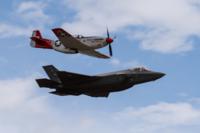As any general will tell you, winning a war is about logistics: getting the stuff to the fight. During World War II, the United States needed to get tons of war material and millions of men and women to overseas postings.
American industrialist and Liberty ship builder Henry Kaiser teamed with billionaire aircraft designer Howard Hughes to create a large cargo transport plane to do the job. Wartime restrictions on the use of steel and aluminum forced the duo to get creative with their solution. The result was the Hughes H-4 Hercules, a massive, wooden flying boat.
In the early days of World War II, Kaiser saw wartime seaborne shipping to Britain being sunk in overwhelming numbers by German U-boats. He wanted to mitigate that problem by taking cargo to the skies, but air cargo planes at the time could not possibly deliver supplies in the amounts needed to keep the Allies fighting in Europe and beyond.
Kaiser approached Hughes, who was then a film director while still being a pioneering aircraft engineer. Hughes agreed to design a prototype with Kaiser that could haul 150,000 pounds of materiel, the equivalent of 750 troops geared for combat or two Sherman tanks.

Hughes and his chief designer, Glenn Odekirk, poured over possible designs for the airframe, including the number of engines (eventually, eight were needed) and the plane's construction materials. With wartime rationing in place, it was decided the prototype had to be made of wood, specifically birch.
The process used to produce an aircraft capable of heavy lift from a wood construction was called Duramold. Duramold laminated the birch together with a resin that made the material 80% stronger than aluminum. The process had been used to make fighter aircraft in the United Kingdom since the early 1930s.
Hughes' H-4 Hercules would be constructed almost entirely of Duramold wood, which earned it the nickname "Spruce Goose" in the press. Despite spending $22 million from government funding and $18 million of his own money, more than $515 million in today’s dollars, Hughes didn't complete the project in time to make a difference in the war.
Kaiser would eventually leave the project in 1944 because the Allies no longer needed such a heavy cargo aircraft. The wartime need had shifted to heavy bombers, and Kaiser was frustrated with the long delay in producing the H-4.
When it was finally finished in 1947, the Spruce Goose's wingspan was more than 320 feet, the plane was 218 feet long and almost 80 feet high. It dwarfed the most common cargo plane of the time, the Douglas C-47 Skytrain. The C-47's wingspan was less than a third of the Hercules and was less than 64 feet long. It was capable of carrying just 27 fully equipped troops.
At the time, the Spruce Goose was the largest aircraft ever built, and held the record until April 2019, when the Stratolaunch jet first took flight. Hughes' wood creation is still the largest propeller airplane, the largest wooden airplane and the largest seaplane ever constructed.

In the end, the H-4 Hercules only flew once, for 30 seconds at an altitude of 25 feet above the ocean in Long Beach Harbor, near its construction site in California. With his crew and engineers aboard, along with a handful of journalists, Hughes made an unannounced flight to prove the Spruce Goose was able to take off.
The Spruce Goose was warehoused for 33 years until Hughes died in 1976. Six years later, the plane was then put on display in Long Beach Harbor for public viewing. In 1992, it was moved to the Evergreen Aviation & Space Museum in McMinnville, Oregon, where it can be seen today.
For more information about Howard Hughes and the Spruce Goose or to plan a trip to see the H-4 Hercules, visit the Evergreen Aviation & Space Museum website.
-- Blake Stilwell can be reached at blake.stilwell@military.com. He can also be found on Twitter @blakestilwell or on Facebook.
Want to Learn More About Military Life?
Whether you're thinking of joining the military, looking for post-military careers or keeping up with military life and benefits, Military.com has you covered. Subscribe to Military.com to have military news, updates and resources delivered directly to your inbox.
















